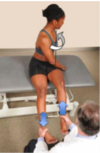Lab 6: Sacrum and BLT Treatments Flashcards
1
Q
Bilateral Sacral Extension
A
Position:
- Patient: supine
- Physician: side of table
Treatment:
- Use the caudal palm to lifts both sacral ILAs anterior to the point of ligamentous balance.
- Use cephalad hand to gap SI joint.
- Patient is instructed, “Take a very deep breath and hold it as long as possible.”
- The physician makes minor adjustments to maintain ligamentous balance.
- Repeated until the best motion is obtained (average is 3 times).
- Recheck

2
Q
Bilateral Sacral Flexion
A
Position:
- Patient: supine
- Physician: side of table
Treatment:
- Use the caudal palm to lifts both sacral bases anterior to the point of ligamentous balance
- Use cephalad hand to extend L5, encourging sacral flexion.
- Patient is instructed, “Take a very deep breath and hold it as long as possible.”
- The physician makes minor adjustments to maintain ligamentous balance.
- Repeated until the best motion is obtained (average is 3 times).
- Recheck

3
Q
Forward Sacral Torsion
A
Position:
- Patient: supine
- Physician: ipsilateral side of table as the sacral base rotation
Treatment:
- Caudal hand: Use the fingers to apply anterior pressure to the deep sacral base to the point of balanced ligamentous tension.
- Cephalad hand: bridge the ASIS’s to gap the SI joints OR assist caudal hand pushing the sacral base anterior or L5 extension.
- The respiratory phases are tested and the patient is instructed to hold his/her breath as long as possible in the phase that provides the best ligamentous balance.
- Step 3 is repeated until the best possible motion is obtained.

4
Q
Backwards Sacral Torsion
A
Position:
- Patient: supine
- Physician: ipsilateral side of table as the sacral base rotation
Treatment:
- Caudal hand: Use palm to apply anterior pressure to the anterior ILA to the point of balanced ligamentous tension.
- Cephalad hand: bridge the ASIS’s to gap the SI joints or assist by flexing L5.
- The respiratory phases are tested and the patient is instructed to hold his/her breath as long as possible in the phase that provides the best ligamentous balance.
- Step 3 is repeated until the best possible motion is obtained.

5
Q
Posterior Innominate Rotation
A
Position:
- Patient: seated
- Doctor: seated in front of the patient
Hand Position: holds distal tibias
Technique:
- Slowly push up on ipsilateral leg and simultaneously pull down on the contralateral leg.
- Attain the balance point.
- Instruct patient to rotate trunk towards ipsilateral side until the ipsilateral leg begins to draw upward with the motion.
- Attain the new balance point.
- Instruct the patient to inhale deeply and hold for 5-10 seconds.
- Release position & reassess.

6
Q
Anterior Innominate Rotation
A
Position:
- Patient: seated
- Doctor: seated in front of the patient
Hand Position: holds distal tibias
Technique:
- Slowly pull down up on ipsilateral leg and simultaneously push down on the contralateral leg.
- Attain the balance point.
- Instruct patient to rotate trunk towards contralateral side until the contralateral leg begins to draw upward with the motion.
- Attain the new balance point.
- Instruct the patient to inhale deeply and hold for 5-10 seconds.
- Release position & reassess.



